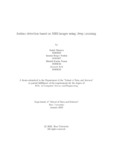| dc.contributor.advisor | Hussain, Dr. Muhammad Iqbal | |
| dc.contributor.author | Mostafa, Sadab | |
| dc.contributor.author | Noshin, Tasnim Hoque | |
| dc.contributor.author | Xenon, Zihadul Karim | |
| dc.contributor.author | Arbi, Jimmati | |
| dc.date.accessioned | 2023-08-01T05:57:14Z | |
| dc.date.available | 2023-08-01T05:57:14Z | |
| dc.date.copyright | 2023 | |
| dc.date.issued | 2023-01 | |
| dc.identifier.other | ID: 18201132 | |
| dc.identifier.other | ID: 18201107 | |
| dc.identifier.other | ID: 18201046 | |
| dc.identifier.other | ID: 18201023 | |
| dc.identifier.uri | http://hdl.handle.net/10361/19231 | |
| dc.description | This thesis is submitted in partial fulfillment of the requirements for the degree of Bachelor of Science in Computer Science and Engineering, 2023. | en_US |
| dc.description | Cataloged from PDF version of thesis. | |
| dc.description | Includes bibliographical references (pages 53-56). | |
| dc.description.abstract | Autism spectrum disorder (ASD) is a neuro dysfunction or neurodevelopmental
disorder. This causes a patient to have trouble with social interaction which causes
social instability. It also causes speech problems or difficulty with any sort of verbal
communication as well as nonverbal communication. The biggest issue with Autism
is that it is difficult to diagnose it at an early level. The difficulty in diagnosing is due
to the lack of a particular medical test for it. Researchers have yet to discover a bio marker or specific gene that can detect autism. Doctors still use outdated methods
to identify autism nowadays. Doctors frequently keep track of a patient’s behavior
since childhood. To address this issue and diagnose autism, artificial intelligence
will be used in our research to develop an ASD diagnosis method. Our research will
employ neuroimages. Functional MRI and Structural MRI images will be used to
train our neural network model.
ABIDE, a versatile dataset was used to initialize this research. This includes struc tural MRI and fMRI data from young and old ASD patients as well as healthy
individuals. After examining the MRI pictures, a method was developed to pick out
particular layers from those images. The dataset was then constructed using images
from ABIDE for our models to train and test without performing any pre-processing.
A variety of cutting-edge deep learning architectures were chosen to train using our
created dataset. Novel architectures were used to attain an accuracy of 80% to
practically 86%. Custom block was used later in the research to expand the dataset
and achieve more accuracy.
Finally, based on our findings, a model will be found that can more accurately
identify autism from MRI pictures. | en_US |
| dc.description.statementofresponsibility | Sadab Mostafa | |
| dc.description.statementofresponsibility | Tasnim Hoque Noshin | |
| dc.description.statementofresponsibility | Zihadul Karim Xenon | |
| dc.description.statementofresponsibility | Jimmati Arbi | |
| dc.format.extent | 56 pages | |
| dc.language.iso | en | en_US |
| dc.publisher | Brac University | en_US |
| dc.rights | Brac University theses are protected by copyright. They may be viewed from this source for any purpose, but reproduction or distribution in any format is prohibited without written permission. | |
| dc.subject | Deep learning | en_US |
| dc.subject | Autism | en_US |
| dc.subject | Neuroimages | en_US |
| dc.subject | Biomarker | en_US |
| dc.subject | MRI | en_US |
| dc.subject | ABIDE | en_US |
| dc.subject | Generative Adversarial Network (GAN) | en_US |
| dc.subject.lcsh | Autism. | |
| dc.subject.lcsh | Neural networks (Computer science) | |
| dc.title | Autism detection based on MRI images using Deep Learning | en_US |
| dc.type | Thesis | en_US |
| dc.contributor.department | Department of Computer Science and Engineering, Brac University | |
| dc.description.degree | B. Computer Science and Engineering | |

